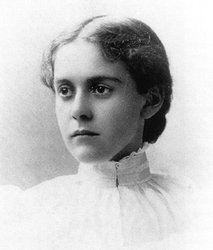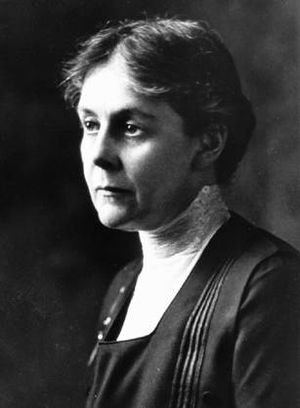Hamilton, Alice (About the EoE)
Hamilton, Alice
Alice Hamilton (1869–1970) was a founder of industrial toxicology in the United States. Her long career investigating the hazards to which workers were exposed—especially from contact with poisonous materials—earned her great gratitude and respect, even from many of the industrialists whose businesses she studied. As Bradley Dewey, president of Dewey and Almy Chemical Company, wrote in 1934 to the technical director of a firm that sold solvents:

I don't know what your Company is feeling as of today about the work of Dr. Alice Hamilton on benzol benzene poisoning. I know that back in the old days some of your boys used to think that she was a plain nuisance and just picking on you for luck. But I have a hunch that as you have learned more about the subject, men like your good self have grown to realize the debt that society owes her for her crusade. I am pretty sure that she has saved the lives of a great many girls in can-making plants and I would hate to think that you didn't agree with me. (Dewey to S. P. Miller, 9 February 1933, Alice Hamilton papers, no. 40, Schlesinger Library, Radcliffe College, quoted in Barbara Sicherman, Alice Hamilton: A Life in Letters Mass.: Harvard University Press, 1984.
Hamilton was one of four daughters and a son born to one of the founding families of Fort Wayne, Indiana. Her sister Edith became famous as the author of The Greek Way (1930) and other works about classical culture, after a career as the headmistress of a girls' school in Baltimore. Alice planned to become a medical doctor. After attending a girls' boarding school that gave scant attention to science, she spent a summer being tutored in chemistry and physics before entering the University of Michigan Medical School. (At that time U.S. medical schools accepted students directly from high school.) At Michigan she became fascinated with the subject of pathology and decided to become a research scientist rather than enter clinical practice. After completing her medical training, she returned briefly to the University of Michigan for graduate studies, but soon she and her sister Edith set out for Germany to pursue their respective fields—bacteriology and classics. Unlike their male counterparts, the sisters were not welcomed into the German universities. Robert Koch, a founder of bacteriology, and Paul Ehrlich rejected Alice Hamilton's request to work with them in Berlin, but she was well received by Ehrlich's former colleagues in Frankfurt, including his cousin, Carl Weigert. Upon her return to the United States, Hamilton became a research assistant at Johns Hopkins Medical School, where she worked mainly with Simon Flexner, a pathologist who went on to head the Rockefeller Institute in New York.
In 1897 Hamilton accepted an appointment as professor of pathology at the Women's Medical School of Northwestern University, which was dissolved soon after. She later worked as a bacteriologist at Chicago's Memorial Institute for Infectious Diseases. In Chicago she lived for many years at Jane Addams' Hull House, the most famous of the settlement houses founded by churches and universities at the dawn of the 20th century. Settlement houses, staffed by idealistic college graduates, offered help to immigrants and other poor people who lived and worked in congested and run-down inner cities. Among the projects she carried out at Hull House, Hamilton applied her medical expertise to finding the causes for the high incidence of typhoid fever and tuberculosis in the surrounding community. In the tuberculosis study she identified bad working conditions as one of the factors that weakened the resistance of poor immigrants to the disease.
Because of Hamilton's public health experience, in 1908 the governor of Illinois appointed her to the Illinois Commission on Occupational Diseases. The commission decided to conduct a broad survey of industrially related diseases in Illinois—a groundbreaking study, which Hamilton agreed to oversee. From 1911 to 1920 she served as a special investigator for the federal Bureau (later Department) of Labor. A landmark study done by Hamilton while in this position concerned the manufacture of white lead and lead oxide, substances that were then commonly used as pigments in the paint industry, and she made recommendations for safer working conditions. (The danger of lead poisoning among members of the general population—especially children—had not yet been recognized.) Among her other famous studies was her work investigating the poisonous effects of manufacturing explosives on workers, a study undertaken during World War I—a war she opposed on pacifist grounds—at the request of the National Research Council.
In 1919, as the leading expert in the field of industrial medicine, Hamilton was appointed assistant professor at Harvard Medical School, whose faculty and student body were all male. She was in fact the first woman professor in any field in the entire university. The mutually agreeable plan was for her to be in residence six months of each year; the rest of the time was to be spent on her surveys. In part because of this unusual arrangement, when she retired in 1935, she was still an assistant professor.
Over the years Hamilton played a prominent role in turning the attention of government and industry to the poisonous effects of aniline dyes, carbon monoxide, mercury, tetraethyl lead, radium (in wristwatch dials among other uses), benzene, the chemicals in storage batteries, and carbon disulfide and hydrogen sulfide gases created in the manufacture of viscose rayon.
Throughout her long life Hamilton maintained an active concern for international affairs and individual civil liberties. She was a member of the League of Nations Health Committee from 1924 to 1930. Because of the threat to humanity posed by the Nazis, she supported the entry of the United States into World War II—in contrast to her stance on World War I. Because she often publicly supported the right of people to hold and express unpopular views, she attracted the suspicion of authorities, and her activities were followed by the Federal Bureau of Investigation, even when she was in her 90s.
Further Reading
